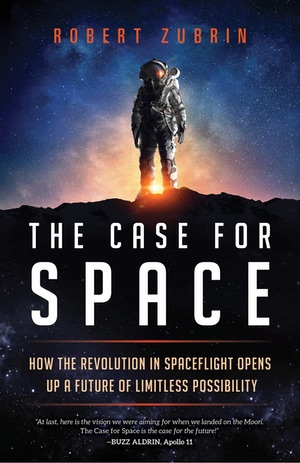Review: The Case for Spaceby Jeff Foust
|
| While Mars has long been a focus of Zubrin’s research and advocacy, it’s only a bit player in this book; one chapter of many about the technologies and techniques needed to travel beyond Earth. |
Robert Zubrin might consider that ambitious vision a good start. While best known as an advocate for the human exploration of Mars, and developer of the Mars Direct architecture to get there, Zubrin sees Mars as just one relatively early step of humanity’s expansion into the solar system and beyond. In The Case for Space, he lays out his own vision for how humanity will expand beyond Earth, although it’s not clear audiences will find his arguments convincing.
The first, and larger, part of the book is focused on answering the questions of how. In a series of chapters, he steps outwards from Earth, starting with challenges of getting into orbit and then on the Moon, Mars, and elsewhere. While Mars has long been a focus of Zubrin’s research and advocacy, it’s only a bit player in this book; one chapter of many about the technologies and techniques needed to travel beyond Earth. To be certain, he does discuss Mars Direct, now with a 2026 date of the launch of the first mission (about a quarter-century later than his original concepts for it), but also includes discussions of his Moon Direct alternative to NASA’s lunar exploration plans (see “Gateway versus tollbooth”, The Space Review, June 4, 2018) and his older “transorbital railroad” concept (see “A transorbital railroad to Mars”, The Space Review, May 23, 2011).
The second part of the book tackles the question of why humanity should move out in the universe. The reasons are familiar ones, from scientific discoveries to new technologies to the survival of humanity itself. For example, Zubrin reiterates a belief, dating back to his The Case for Mars book more than 20 years ago, that a human settlement on Mars will require ingenuity to survive, stimulating new technologies from robotics to fusion power that might not be developed on Earth.
Zubrin offers a comprehensive plan, one rich in technical detail—perhaps too rich at times, with some passages filled with equations describing chemical processes needed to extract resources on Mars or other worlds or discussing the physics of advanced propulsion technologies. But it seems a little fanciful to talk about concepts for interstellar travel like antimatter and magnetic sails when we find it so difficult today simply to get to low Earth orbit reliably and inexpensively. Even Zubrin acknowledges that, centuries from now, “our present ideas about future spaceflight will probably appear far more quaint than those of the best nineteenth-century visionaries do to us today.” But, he argues, he seeks to stay within the science that is known today as he speculates about what the future—far future, perhaps—looks like.
The “why” section is not just the shorter part of the book, but also the weaker. The arguments he makes are familiar ones, and often don’t stand up to scrutiny. He emphasizes the importance of studying the universe, and protecting the Earth from asteroid impacts, but neither requires or even can be substantially aided by the presence of humans (he claims that “surveyors, geologists, miners, drillers, and demolition experts will be needed on the scene to do the job right” for any mission to deflect a threatening asteroid, yet planetary defense experts rarely, if ever, talk about the need for crewed deflection missions.)
| The “why” section is not just the shorter part of the book, but also the weaker. |
In another chapter, he complains about a lack of technological innovation since the 1980s, claiming that if the pace of past innovation had been maintained we would have everything from flying cars to hypersonic aircraft by now. He admits there have been “noteworthy” advances in information technology during this period, but seems underwhelmed; yet, the advances in computing and networking that, for example, make it possible for you to read this anywhere in the world on a supercomputer that fits in your pocket, have had a tremendous impact on society, for good or ill, that’s on a par with advances in transportation in the 20th century.
So, who is the audience of The Case for Space? Most people who consider themselves space advocates are already on board with his vision for humanity’s future in space, but might quibble with his choices of destinations, technologies, and the like. Those less familiar about space might get overwhelmed with the long technical discussions about interplanetary and interstellar flight, and not make it through the “why” discussions that follow with the call to action at the end: become a space activist and join relevant organizations, including his own Mars Society as well as several other groups. Given the limited progress we’ve seen towards humans on Mars in the more than two decades since Zubrin wrote The Case for Mars (which led to the formation of the Mars Society), that call to action pales in comparison with the action Bezos is undertaking to achieve his own vision of humanity in space.
Note: we are temporarily moderating all comments subcommitted to deal with a surge in spam.
